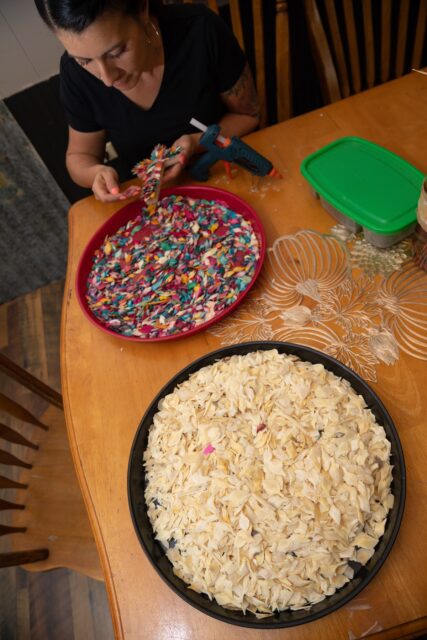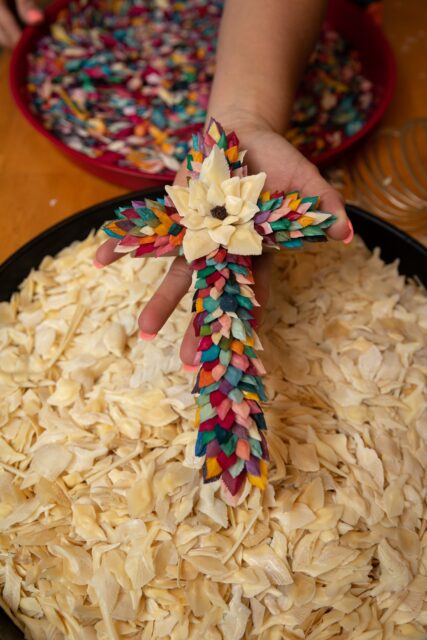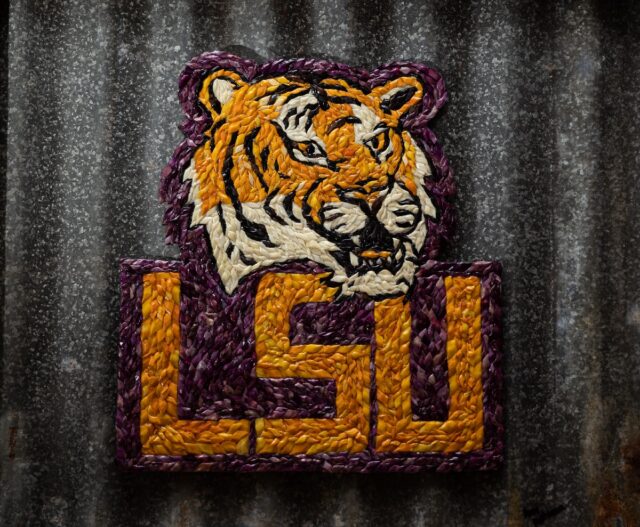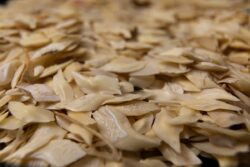Summer 2021
Crafting to Scale
Women in a Houma family adapt a utilitarian tradition to artistic ends
Published: May 28, 2021
Last Updated: March 22, 2023
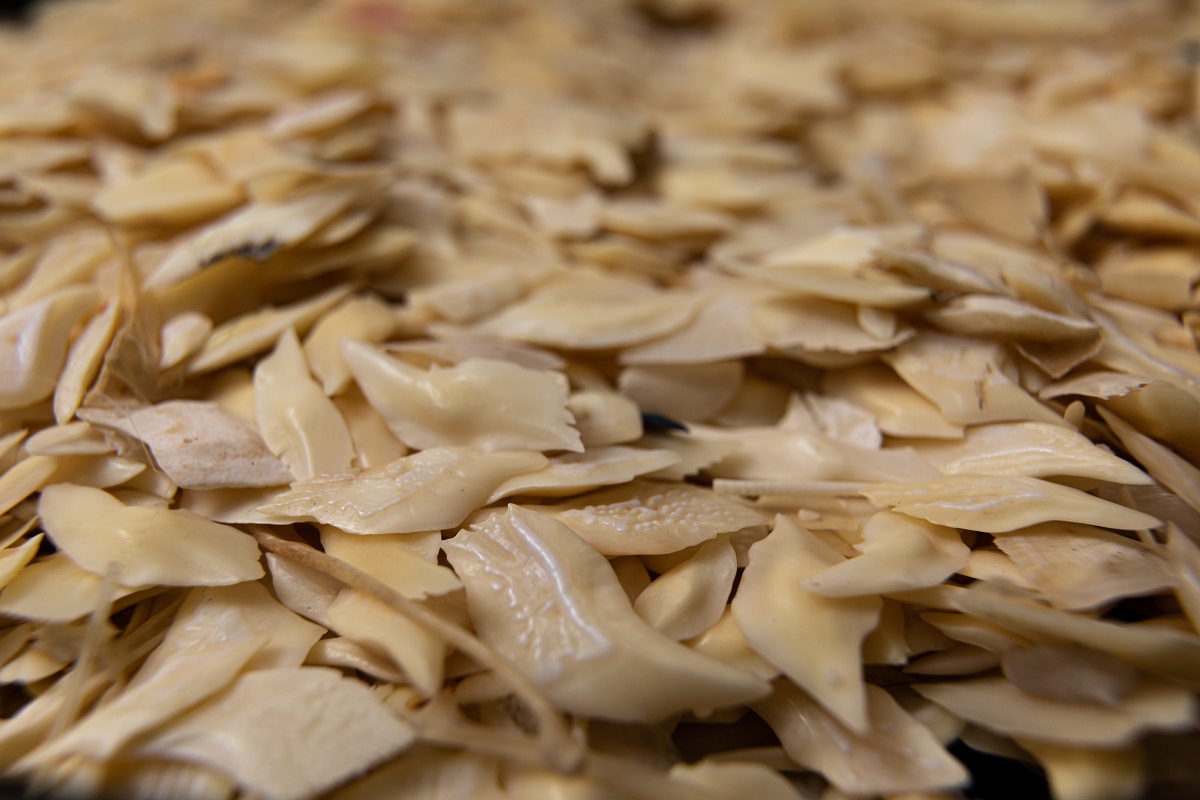
Photo by Brian Pavlich
Scales ready for dyeing.
Endemic to the southeastern United States from east Texas to the Florida panhandle, the imposing fish, little changed in tens of millions of years, plies waters both fresh and brackish, its ability to gulp air allowing for forays into low-oxygen environments. The animal’s long, cylindrical body, on average weighing 150 pounds, bears hard interlocking scales with a glassy mineral coating, inspiring its name le poisson armure in French-speaking South Louisiana. Below this defensive layer lies a bounty of firm white meat, making the alligator gar a staple food source for the Houma peoples and their coastal neighbors. For Luster, however, the lustrous diamond-shaped scales represent the real prize as she adroitly transforms them into flower pins, jewelry, and other art objects.
Indigenous communities had long used garfish scales as arrow points for hunting prey, but Luster credits her mother Mary for envisioning a less utilitarian application for the plate-like structures. Elicited by her desire to dress up the spartan fishing camp built by her husband John in the 1940s, Mary began collecting the thick skins he cleaned from his daily garfish catch. At home she took the remains to a nearby deer stand to allow insects to do the work of removing the soft tissues and, once scoured, dyed them with berries or onion skins. She then assembled the tinted petal-like scales into delicate blooms held together by terre gras, a thick blue-hued clay found in the region’s wetlands. The sculpted flowers became her desired home décor.
Luster took up her mother’s craft in the early 1970s, adopting the basic elements while gradually incorporating her own techniques and materials. A hot glue gun replaced the sticky mud of decades past, while store-bought dyes added an array of vibrant colors. Additionally, the use of commercially available acrylic sealants ensured the work’s longevity. In 1992 she swapped the plastic beads she had once used to mimic the flowers’ center for mustard seeds, a change allowing for an easy identification of her early works. Luster also introduced a signature flourish: the placement of five green scales, representing her five children, on the back of her creations.
Eager to amass an inventory at the onset of her enterprise, she found her mother’s method of “curing” scales protracted and sought faster ways to remove the species’ meat and skin. She landed on boiling the boney hides in a crab pot for half a day, a significant decrease from the three months required for natural decomposition. As she accumulated a surplus of scales—a profusion that today spills out of her house and into an old tub in the yard—she eventually reverted to her mother’s unhurried approach. The final steps, however, are far from speedy. The scales must soak for six to ten hours in a solution of bleach and water and then, to lose their chlorine smell, spend several days outside.
Luster’s artistry unfolds in her use of color, derived from synthetic dyes as well as natural pigments from leaves, berries, and other organic matter. The level of coloration varies according to the duration of time the porous scales stay submerged: thirty minutes result in a pale tint while several hours yield a darker stain. Too long, however, and the color begins to recede due to the scales’ residual chlorine. The age of the animal also affects the outcome, as the soft armature of young alligator gar absorbs more readily than that of their older counterparts. Even with her years of experience, Luster admits that with so many factors, surprising variations in color still occur.
The labor-intensive production requires the involvement of numerous family members, beginning with Luster’s cousin Ricky, who catches the gar using jug lines: baited hooks attached to soda bottles with nylon twine. His typical haul brings in five to ten fish, each supplying approximately a gallon of scales. Luster’s husband William, along with their daughters and grandchildren, are enlisted when needed to clean, sort, and transport scales. The additional hands allow for a continuous and efficient operation.
Of Luster’s five children, her second-born daughter Ann has most enthusiastically embraced the art form. Joking that she must have teethed on garfish scales as an infant, Ann began making her own creations as a seven-year-old. She experimented with various dyes as she got older, even using the rose petals from her wedding bouquet to give one collection of scales a rich burgundy hue. Ann fabricates flower pins similar to those of her mother, and the pair’s oeuvre also includes an assortment of earrings, crosses, and framed renderings of anchors, hearts, and other commissioned designs.
The sale of such items provides an important source of income for the mother and daughter. Indeed, in the early 1990s after Hurricane Andrew leveled swaths of south Terrebonne and a car accident forced her husband onto disability, Janie supported the family by selling her pieces to the multitude of volunteers who came to assist with relief efforts. Other disasters, however, have crippled their operations, such as 2010’s Deepwater Horizon oil spill, which created a scarcity of scales when fishing came to an abrupt halt. The COVID-19 pandemic, while not hindering supply levels, has nearly eliminated their customer base by forcing the cancellation of festivals and other large public events where most of their sales occur. Today purchases come via the occasional Facebook inquiry or, in a less high-tech fashion, through a nearby charter-fishing company, where visitors shop from a modest display of the Lusters’ garfish creations and leave payments in a jar.
Fortunately, grant monies from national and state agencies have offset some of these losses by paying Janie and Ann to lead public workshops in communities across the coastal parishes. Some techniques stay within the immediate family, but they express little concern that others will eclipse their trade, given its time-consuming nature. They have a particular investment in teaching the children of the United Houma Nation, underscoring the cultural significance of garfish and the tribe’s interdependence with the land they have inhabited for millennia. In this historical context, garfish art remains a relatively novel folk expression, but its continuity across four generations of Janie Luster’s family proves its vitality and capacity for longevity.
Chair of the Louisiana Folklife Commission Teresa Parker Farris is an independent folklorist based in New Orleans. She holds an MA in Southern Studies from the University of Mississippi and is currently a PhD candidate at Tulane University. Her research focuses on the vernacular traditions and cultural history of American South.
 Support for this story was provided by the St. Bernard Tourist Commission. St. Bernard Parish offers tranquil surroundings, cultural treasures steeped in history, and beautiful waterways made for fishing, hunting, and birdwatching. Map out your adventure to New Orleans’s most historic neighbor today at visitstbernard.com.
Support for this story was provided by the St. Bernard Tourist Commission. St. Bernard Parish offers tranquil surroundings, cultural treasures steeped in history, and beautiful waterways made for fishing, hunting, and birdwatching. Map out your adventure to New Orleans’s most historic neighbor today at visitstbernard.com.
